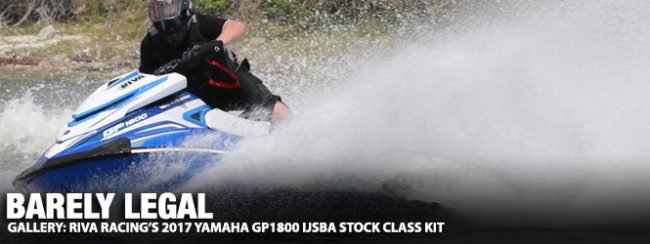
We’ll just get right to it: When we first rode the 2017 Yamaha GP1800 WaveRunner it was well, pretty darn-near perfectly balanced, both literally and figuratively. Yamaha kept the size and weight of the ski manageable by using its NanoXcel2 hull and deck material, which not only reduces total weight (totaling 769 pounds), but also strengthens the final mold’s bond and tensile strength over traditional SMC composites. With this, Yamaha created a machine 18-pounds lighter than the NanoXcel VXR and 22-pounds less than the retired FZR; and that’s including the SVHO supercharged 1.8L four-stroke, and 160mm, 8-vein impeller mounted in a 75mm hub, a quick-response electric trim system, a folding swim step and RiDE, Yamaha’s dual throttle braking system.
The ergonomics of the ’17 Yamaha GP1800 WaveRunner are simple, to the point and serviceable. The steering system is fixed with fun color-matched pistol-inspired grips, the two-tone “cut-and-sew” stitched saddle is notably narrowed at the knees. CNC-cut traction mats fill the footwells and cover the deck. The LCD “multifunction information center” (ie. gauge cluster) – although unique to the GP – is a little underwhelming in its lack of a boost gauge “and other high-end data that gearheads would love to see,” as we stated in our initial review. The two color schemes: Azure Blue Metallic or Torch Red Metallic, give the buyer an option of livery, but little else varies. Again, the GP1800 is a down-to-brass-tax kinda watercraft…

…And performance is what the GP1800 is all about. Acceleration is aggressive but not brutal, as the 265 brake horsepower, 1,812cc engine opens up wide and inhales a compressed blend of 92-octane and cool, dense air through its 54mm throttle body. At an open gallop, we reached a top speed of 68.8mph on a Garmin GPS (at 7,400rpm) that was rock solid. Yet, it is in the twisties where the GP1800 shines brightest. The WaveRunner rides high on the surface while retaining significant pump engagement even in moderate chop. For the most part, the GP1800 turns surprisingly flat, that is until properly coaxed. The narrow, scalloped seat allows for faster weight transitions from side-to-side, allowing the rider to drop a knee deep into the well and shift far over and low into the turns.
So what could RIVA Racing really do to improve upon such a machine? The world-leader in performance PWC hardware and engine management software was well-stocked with a slew of products to unlock the GP1800 from its USCG shackles. The newest member of the RIVA Development team, Jesus Garcia, who is over RIVA’s engine management development, specifically the MapTunerX, knew it wouldn’t be as simple throwing what they already had at it. To create a package that would comply with IJSBA (International Jet Sport Boating Association) Stock class runabout rules, certain specifics to the tuning software would need to be adjusted to compensate for the lack of permissible performance products. Stock class requires that factory exhaust remain in place as well as all internals concerning the engine. Constrained to almost entirely external handling items and an ECU tune, the challenge was on.

The end result (after months of tuning at RIVA’s private test lake) was a package that delivered a blistering 83mph at 8,650rpm. The RIVA Racing 2017 Yamaha GP1800 IJSBA Stock Class Race Kit consists of a RIVA MaptunerX Yamaha 1.8L Bundle (PT# RY110SC-B), a RIVA Yamaha GP1800 Power Filter Kit (PT# RY13110), RIVA Billet Pump Strainer for Yamaha SVHO (PT# RY1013-WS-80), a RIVA Yamaha GP1800/VXR/VXS Top-Loader Intake Grate (PT# RY22110), a Solas Yamaha 160mm Concord 13/18 Impeller (PT# YV-CD-13/18), a RIVA Yamaha GP1800 Pump Seal Kit (PT# RY25110), and a RIVA Yamaha GP1800/VXR/VXS Performance Ride Plate (PT# RY21110). And if you’re wondering about the sponsons, those aren’t quite done yet. The pair that we tested this day were prototypes, and while the pictures show a finished product, they were far from it. “These will be our most aggressive sponsons we’ve ever made,” RIVA’s Dave Bamdas beamed. “We’re still working on getting them ready for market, so it’ll be a few more months.”
While the finished blades won’t provide the Stock class kit any more top speed, the promised gains in handling (particularly in ocean and severely choppy water) are substantial. “They’re pretty remarkable,” Bamdas continued to tease. “We’ve never made a sponson like this. We’re really excited to hear the feedback.” For what it’s worth, the “temporary” sponsons we tested with were stellar. Initial bite and full throttle lateral-g turns revealed a machine that leaned securely as if hard-mounted to a roller coaster rail, turning incredibly flat in corners, giving the rider a body-torsion inducing slot-car sensation. Regardless of body weight distribution, the tail refused to break free, and top speed through a variety of surfaces remained true and predictable – almost eerily so. It was, and with no need for hyperbole, more watercraft than we could handle.

Beneath the seat, only the cold air induction kit and the reflashed ECU (via a MaptunerX handheld tuner)converted the once civilian-friendly GP1800 into an unbridled beast. Power response is immediate – not neck-snapping but linear, pulling up hard and consistent and climbing deep into the 80s. RIVA cautions that the limitations of Stock class prohibit the use of a RIVA SVHO Engine Cooling Upgrade Kit and RIVA Power Cooler Kit so the recreational rider will want to spring for these to ensure maximum engine life. Additionally, the eagle-eyed reader will note the RIVA Yamaha GP1800/VXR/VXS Pro-Series Steering System. That too isn’t part of the RIVA IJSBA Stock class kit, but makes a considerable difference in rider input and steering response.
Nearly a decade ago, we labored for 2 days under the blazing Arizona sun to push a then-new ’08 Yamaha FZR to 80 miles-per-hour. It took well over $8,000 worth of products, an excessive amount of trial testing and long nights of invasive procedures and fuel curve tweaking, but we accomplished our goal: 80.1mph. Today, with less than $2,300 in bolt-on parts that are easily installed on a Saturday in the comfort of your own garage, speeds handily eclipsing that ancient achievement can be had thanks to RIVA Racing. Considering the GP’s $13,999 MSRP (undercutting the FZR’s $14,799 price tag by $800) and RIVA’s listed kit price of $2,272.35, never before has a race-ready, world championship-worthy machine been so dramatically affordable to the layman. Arming civilians with such a weapon would almost be considered irresponsible were it not so much stinkin’ fun.



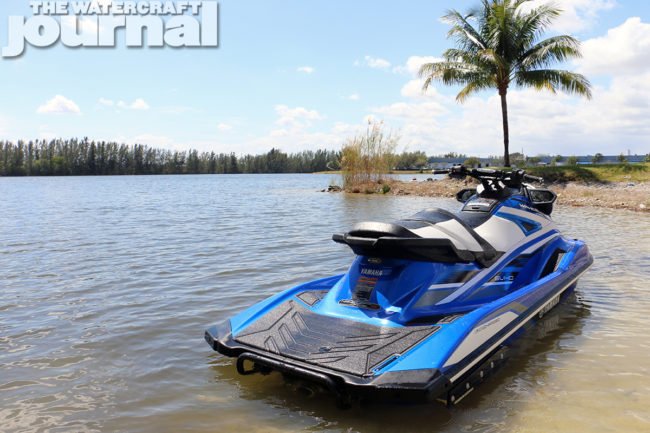
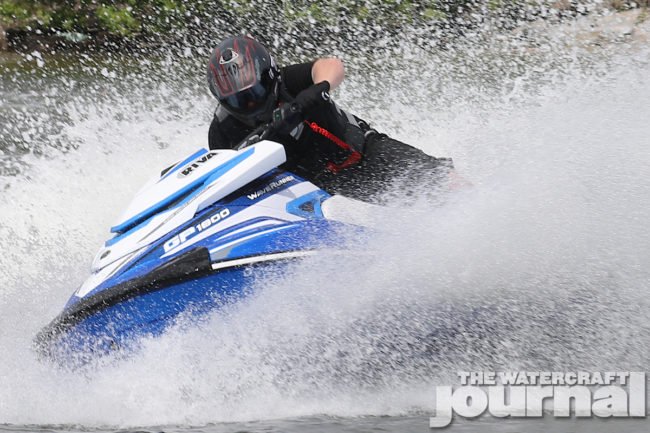






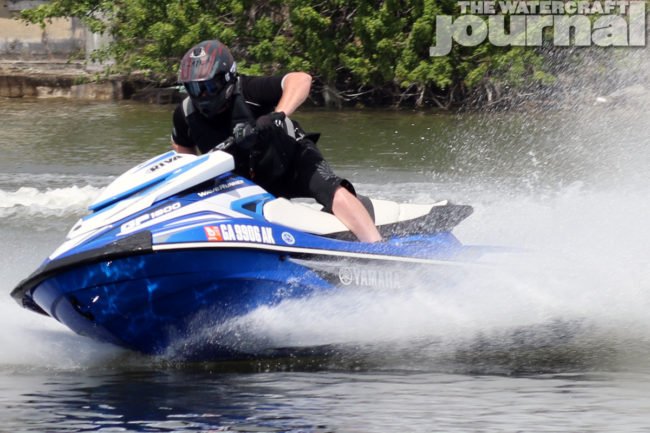




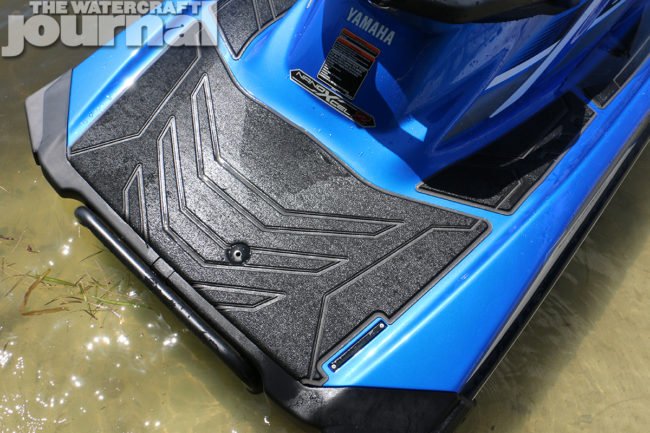






















Very professional video review. Man to Man, great Radio/TV voice.